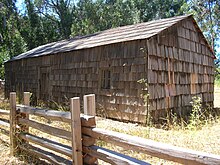Andrew Molera State Park
| Andrew Molera State Park | |
|---|---|
California Department of Parks and Recreation |
Andrew Molera State Park is a 4,800 acres (1,900 ha),
Activities
Activities at the park include
The park is 20 miles (32 km) south of Carmel-by-the-Sea on State Route 1.
Features

Andrew Molera State Park features the historic Cooper Cabin, built in 1861 or 1862. It is the oldest structure in Big Sur.[5] Fur trader John Bautista Rogers Cooper was Andrew Molera's grandfather.[2]
The house used by the ranch foreman has been preserved and is used as a museum. It includes displays of Big Sur’s Native American and pioneer history, artists' exhibits, and historical artifacts. The museum is normally open mid-day on weekends during the summer, and in the winter when volunteers are available. The museum is located about .2 miles (0.32 km) south of the parking lot.[6][7] As of March 2022[update], the museum is closed for exhibit cleaning and updates.[8]
The Ventana Wildlife Society has established a Discovery Center within the park. The Discovery Center includes exhibits on local wildlife, including the California condor, and a bird banding laboratory. Scientists and other laboratory employees give regular tours of Andrew Molera State Park, explaining the flora and fauna that are unique to the area.[9]
The park also features a year-round waterfall, 40-foot (12 m) Highbridge Falls. Other nearby waterfalls include Limekiln Falls, Salmon Creek Falls, McWay Falls in Julia Pfeiffer Burns State Park, and Pfeiffer Falls in Pfeiffer Big Sur State Park.

Recreation
Andrew Molera State Park has over 20 miles (32 km) of hiking trails. Some run along the shore, others along the Big Sur River, while still others climb to high ridges with views of the entire Big Sur coast.
The only
Marine protected areas
Point Sur State Marine Reserve and Marine Conservation Area are marine protected areas offshore from Andrew Molera State Park. Like underwater parks, these marine protected areas help conserve ocean wildlife and marine ecosystems.
History
Cooper's son John Bautista Henry Cooper built a home on the ranch in 1899, but died soon after. John B.H. Cooper's sister Francisca Guadalupe Amelia Cooper inherited the southern two sections comprising 4,677.5 acres (1,892.9 ha) of Rancho El Sur. When she died, her two children Andrew J. and Francisca (known as Frances) Molera inherited the land, although they lived their adult lives in San Francisco.[13][14][15][16] The ranch became known as the Molera Ranch.
Andrew J. Molera owned property in the
Frances Molera stipulated that the park should be named Andrew Molera State Park in honor of her brother.[19] She also added provisions to the sale requiring that the land remain relatively undeveloped. She died in 1968. When the California state park administration began to propose considerable development for the park, the Nature Conservancy threatened to revoke the sale arrangement, and the state backed down.[20] The remaining 2,654.7 acres (1,074.3 ha) of Frances Molera's half of the original Rancho El Sur east of Highway 1 was purchased by the state soon after her death. The northern 7,100 acres (2,873 ha) of John. B.R. Cooper's share of the Rancho El Sur comprising 13 parcels is the modern-day El Sur Ranch.[21]
See also
References
- ^ a b "Explore Redwoods". Save the Redwoods League. Retrieved April 15, 2022.
- ^ a b c d e "Andrew Molera SP". California State Parks. Retrieved July 4, 2022.
- PMID 17775206. Archived from the originalon March 19, 2006. Retrieved November 29, 2011.
- ^ "Discover California State Parks in the Monterey Area" (PDF). California State Parks. Retrieved November 29, 2011.
- ^ Davis, Kathleen E. "Big Sur Cabin". California State Parks. Retrieved September 24, 2011.
- ^ "The Ultimate Guide to Andrew Molera State Park". www.california.com. Retrieved March 9, 2022.
- ^ Molera Ranch House Museum (PDF). California Department of Parks and Recreation. Retrieved March 9, 2022.
- ^ "Andrew Molera SP". CA State Parks. Retrieved March 9, 2022.
- ^ "Andrew Molera State Park". Monterey County Convention & Visitors Bureau. Retrieved November 29, 2011.
- ^ "Andrew Molera SP". California State Parks. Retrieved November 29, 2011.
- ^ "Finding Aid to the Documents Pertaining to the Adjudication of Private Land Claims in California, circa 1852-1892".
- ^ Report of the Surveyor General 1844 - 1886 Archived 2013-03-20 at the Wayback Machine
- ^ Year: 1880; Census Place: San Francisco, San Francisco, California; Roll: 78; Page: 76B; Enumeration District: 201
- ^ Year: 1920; Census Place: San Francisco Assembly District 31, San Francisco, California; Roll: T625_136; Page: 16A; Enumeration District: 153
- ^ Year: 1930; Census Place: San Francisco, San Francisco, California; Page: 4B; Enumeration District: 0334
- ^ Year: 1940; Census Place: San Francisco, San Francisco, California; Roll: m-t0627-00318; Page: 3A; Enumeration District: 38-502
- ^ Ferrary, Jeanette. "Artichokes". VIA Magazine (May/June 2000). Archived from the original on March 19, 2006. Retrieved November 29, 2011.
- ^ Walton, John (2007). "The Land of Big Sur Conservation on the California Coast" (PDF). California History. 85 (1). Archived from the original (PDF) on August 22, 2016. Retrieved August 14, 2016.
- ^ "Discover California State Parks in the Monterey Area" (PDF). California State Parks. Retrieved August 12, 2016.
- ISBN 9780520294417. Retrieved March 11, 2018.
- ^ State, California. California. Court of Appeal (6th Appellate District). Records and Briefs: H004844, Judicial Notice. Retrieved February 12, 2018.
